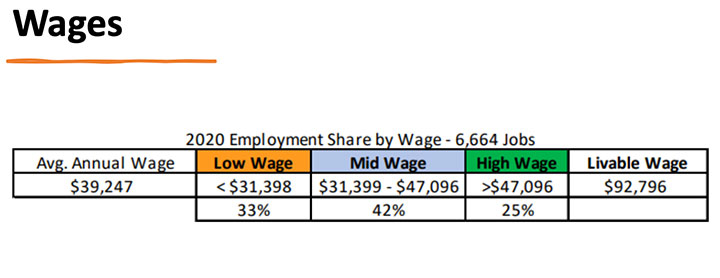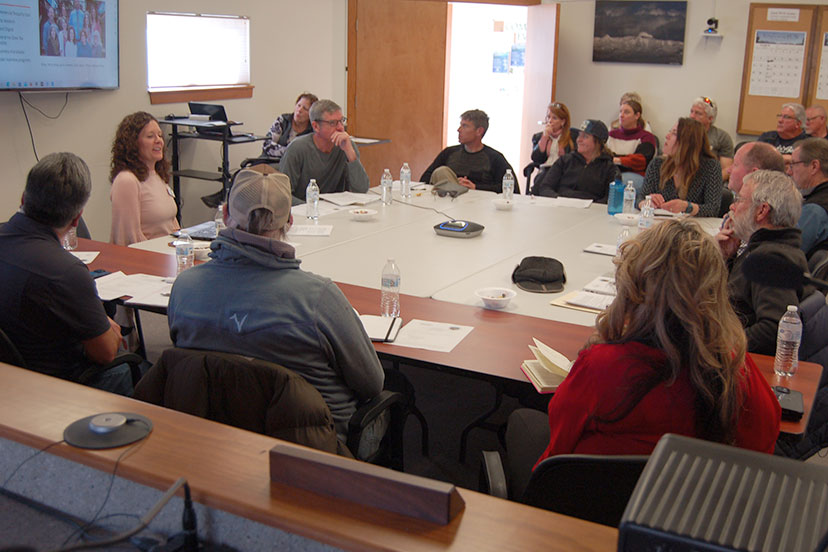PHOTO: Region 9 Project Manager Heather Otter (at left, in pink) shares data and ideas with a joint Town-County meeting on March 28, 2023.
Most of the conversation at yesterday’s joint meeting between the Pagosa Springs Town Council and the Archuleta Board of County Commissioners (and their respective managers) had something to do with spending. But sometimes, only remotely to do with spending.
Or so I am assuming. I left after about an hour and a half to play music with friends at the Tuesday evening ‘open mic’ hosted by Carl Mori at The Den, a few blocks away. But one of the Council members showed up at The Den, later, and let me know that I’d missed half the meeting. So, a three hour meeting.
The half I missed, dealt with:
VI. DISCUSSION OF USES AT SOUTH PAGOSA PARK
VII. TRANSPORTATION, ROADS AND TRANSIT
- CDOT Resurfacing Project
- CDOT McCabe Creek Project
- CDOT Main Street Reconstruction
- Transit Opportunities
- Access Control Plan
VIII. BIG SPRING CLEAN UP: MAY 6TH
IX. OTHER ITEMS OF MUTUAL INTEREST
All important topics, and I’m glad our elected leaders dealt with these issues, so I didn’t have to.
The half of the meeting I listened to, with a number of other audience members, had dealt with:
I. REGION 9 UPDATE
II. TOURISM BOARD INFRASTRUCTURE IMPROVEMENTS RECOMMENDATIONS
III. PROPOSITION 123 – DISCUSSION RELATED TO A JOINT BASELINE OF AFFORDABLE HOUSING UNITS WITHIN THE TOWN AND COUNTY
IV. DISCUSSION OF FORMATION OF POSSIBLE RECREATION DISTRICT
V. RIVER ACCESS
The update from Region 9 — the Region 9 Economic Development District, which includes the counties of Archuleta, La Plata, Montezuma, San Juan, and Dolores, along with the Southern Ute and Mountain Ute tribes — was delivered by Economic Development Project Manager Heather Otter, and lasted about 35 minutes. Ms. Otter touched on:
1. Workforce development — especially at the high school level
2. Accessing data from Region 9
3. Development of opioid programs through SWORD (Southwest Opioid Response District)
4. Assistance with grants
5. The various economic sectors in Archuleta County and how they interact…
That’s not all Ms. Otter talked about, but I’d like to pause here and complain about the data we were shown regarding the Pagosa economy. It’s typical for organizations like Region 9 to define “The Tourism Sector” as the most important sector in our local economy, but without giving us any clear indication of how “The Tourism Sector” is being defined.
For example. Is a restaurant part of “The Tourism Sector”? I was at the Pagosa Baking Company during spring break, and nearly everyone in the place was wearing ski pants. But on Monday, I recognized most of the customers at Pagosa Baking as local residents. I would bet Pagosa Baking exists mainly on local customers from late March through the end of May, and in fact, for most of the year.
I would bet that tourist support of our restaurants is a seasonal occurrence, and that most of our restaurants would dry up and blow away without local customers. Region 9 is very aware of this dynamic, and Ms. Otter mentioned it during her presentation, but she didn’t (or couldn’t) give us definition of what “A Tourism Economy” truly is.
Her presentation continued, by getting into the stressful situation facing our local working families:
“The average annual wage, across the county, is around $39,000…
“I know many of you are aware that Archuleta County got the award for being the most expensive place to live in Southwest Colorado, in the last ‘livable wage’ update that we did. You finally surpassed La Plata County…”
She gave a slightly uncomfortable laugh.
“I want to differentiate between ‘minimum wage’ and ‘livable wage’. Minimum wage is a wage that has to be paid…”
Here in Colorado, the minimum wage is $13.65, and $10.62 for tipped employees. With the passage of Amendment 70 in 2016, Colorado’s minimum wage was increased to $9.30 per hour and was increased annually by $0.90 each January until it reached $12 per hour effective January 2020. Thereafter it is adjusted annually for cost of living increases, as measured by the Consumer Price Index used for Colorado.
“A livable wage is not a minimum wage. A livable wage means, what is the wage that would cover the basic necessities to keep an individual or a family paying their bills without getting any subsidy. This is not ‘putting away a lot of savings and going on vacation’. This is what it takes to live…
“So for a single adult, to live here, just meeting their needs, would need to make about $39,700 a year. When you add children to the mix, it jumps substantially… For a family of four, they would need $92,000…”
Actually, closer to $93,000.

Let’s consider those numbers.
The average wage in Archuleta County is $39,000 a year. That suggests that half of our workers are earning less that $39,000 a year.
If we assume that many, and maybe most, of the workers earning less than $39,000 a year are younger individuals rather than mature, seasoned professionals (which seems like a sensible assumption?) we can then guess that half of our workforce — mostly younger workers — cannot actually afford to live here, unless they can find a ‘group living’ situation where the rent is shared.
Some landlords do not approve of ‘group living situations’. It’s a problem.
On average, two adults with two children might be bringing in two $39,000 salaries. That totals $78,000 a year. But they need $93,000 just to ‘get by’ in Archuleta County.
Either wages are too low… or rents (and utilities and health insurance and car payments and everything else that goes into ‘just meeting their needs’) are too high.
We know the wages are too low. The Root Policy study created for the Town government last November made that very clear. About three decades ago, our local business and government leaders hitched Pagosa’s wagon to a “Tourism Economy”, not fully understanding that a “Tourism Economy” typically pays lousy wages.
The wages are too low. And the rents are also too high.
We have both problems going on.
Ms. Otter moved on to the next subject of her update. She showed a graph, projecting an increasing population in Colorado over the next decade. The number of children actually drops slightly, and the number of seniors, over age 65, increases markedly.

Archuleta County is going to be ‘much older’ in ten years, according to projections…

